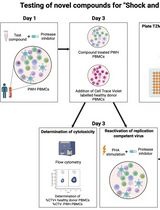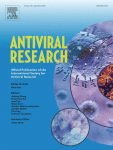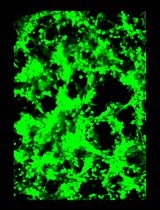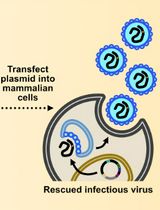- EN - English
- CN - 中文
A Sensitive and Specific PCR-based Assay to Quantify Hepatitis B Virus Covalently Closed Circular (ccc) DNA while Preserving Cellular DNA
一种在保留细胞DNA的同时定量检测乙型肝炎病毒共价闭合环状(ccc)DNA的灵敏、特异PCR方法
发布: 2021年04月20日第11卷第8期 DOI: 10.21769/BioProtoc.3986 浏览次数: 6172
评审: Alessandro DidonnaVasudevan Achuthan

相关实验方案

诱导型HIV-1库削减检测(HIVRRA):用于评估外周血单个核细胞中HIV-1潜伏库清除策略毒性与效力的快速敏感方法
Jade Jansen [...] Neeltje A. Kootstra
2025年07月20日 2393 阅读
Abstract
Hepatitis B virus (HBV) is the major cause of liver diseases and liver cancer worldwide. After infecting hepatocytes, the virus establishes a stable episome (covalently closed circular DNA, or cccDNA) that serves as the template for all viral transcripts. Specific and accurate quantification of cccDNA is difficult because infected cells contain abundant replicative intermediates of HBV DNA that share overlapping sequences but arranged in slightly different forms. HBV cccDNA can be detected by Southern blot or qPCR methods which involve enzymatic digestion. These assays are laborious, have limited sensitivity, or require degradation of cellular DNA (which precludes simple normalization). The method described in this protocol, cccDNA inversion quantitative (cinq)PCR, instead uses a series of restriction enzyme-mediated hydrolysis and ligation reactions that convert cccDNA into an inverted linear amplicon, which is not amplified or detected from other forms of HBV DNA. Importantly, cellular DNA remains quantifiable during sample preparation, allowing normalization and markedly improving precision. Further, a second linear fragment (derived from enzymatic digestion of a separate region of the HBV DNA genome and is present in all forms of HBV DNA) can be used to simultaneously quantify total HBV levels.
Graphic abstract:

Selective detection of HBV cccDNA and total HBV DNA using cinqPCR (Reproduced from Tu et al., 2020a).
Background
Hepatitis B virus (HBV) is a small enveloped virus, which encapsidates a partially double-stranded circular DNA genome, the so-called relaxed circular (rc) DNA. Upon infection of human hepatocytes, the nucleocapsid is transported to the nucleus wherein the rcDNA genome is converted to covalently closed circular (ccc) DNA. This episomal form is highly stable and maintains chronic HBV infection (Tu et al., 2020b). It serves as template for all viral transcripts and the pre-genomic RNA. Elimination of the cccDNA would lead to a complete cure of a chronic hepatitis B infection. Thus, the reliable quantification of cccDNA is key to developing strategies for HBV cure.
In any given infected hepatocyte, HBV DNA exists in different forms (rcDNA, double stranded linear (dsl) DNA, single stranded (ss) DNA, and cccDNA) that share overlapping sequences, but have different structures (Nassal, 2015). Thus, differentiation of cccDNA (which is present in low numbers) from other HBV DNA forms is technically challenging. Southern blot is the gold standard method used to differentiate cccDNA from other forms, though it has low throughput and poor sensitivity. PCR-based methods are more sensitive and can be applied in a medium-throughput manner. Current protocols include an exonuclease treatment (with T5 exonuclease, plasmid-safe DNase, or a combination of ExoI and ExoIII) to digest all DNA species that are not covalently closed (including cellular DNA) (Luo et al., 2017; Allweiss et al., 2018; Qu et al., 2018). By contrast, the method described in this protocol takes advantage of particular restriction sites within the HBV DNA sequence (see graphical abstract) to selectively convert cccDNA into an amplifiable form. Therefore, our method allows the normalization to a single-copy cellular gene and total HBV DNA can be detected from the same sample, dramatically improving precision, sensitivity, and accuracy.
Materials and Reagents
Note: All stored at room temperature unless otherwise stated.
24-well cell culture plates (Corning, catalog number: 3527 )
1.5 ml Eppendorf tubes (Sarstedt, catalog number: 72706 )
Sealing Mats for 96-Well PCR Plates, reusable (Bio-Rad, catalog number: 2239442 )
TwinTec PCR plates, 96 semi-skirted (Eppendorf, catalog number: 0030128.575)
Aluminium Foil Seals for PCR and QX100 ddPCR applications (Bio-Rad, catalog number: 181-4040 )
P20 racked barrier LTS tips (Rainin, catalog number: RT-L20F )
P200 racked barrier LTS tips (Rainin, catalog number: RT-L200F )
HBV-susceptible cells, e.g., HepG2-NTCP cells (Ni et al., 2014) (maintain in 37 °C incubator at 5% CO2 supply and 95% humidity)
HBV genotype D virus stock (store at -80 °C)
Dulbecco’s Phosphate Buffered Saline (PBS, Sigma-Aldrich, catalog number: D8537 )
Dulbecco’s Modified Eagle Medium (DMEM, Life Technologies, catalog number: 41965039 , store at 4 °C)
Fetal bovine serum (FBS, Sigma-Aldrich, catalog number: S0615 , store at -20 °C)
L-Glutamine (Life Technologies, catalog number: 25030024 , store at -20 °C)
Penicillin (10,000 U/ml) Streptomycin (10 mg/ml) (Life Technologies, catalog number: 15140-122 , store at -20 °C)
Dimethylsulfoxide (DMSO, Merck, catalog number: 102950 )
Polyethylenglycol (PEG 8000, 40% solution in PBS, Sigma-Aldrich, catalog number: 89510 )
Trypsin-EDTA solution (Sigma-Aldrich, catalog number: T3924 , store at 4 °C)
NucleoSpin® Tissue kit (Macherey-Nagel, catalog number: 740952 )
Multichannel pipette (Eppendorf, catalog number: 3125000036 )
10× Cutsmart buffer (NEB, catalog number: B7204 , store at -20 °C)
HhaI (NEB, catalog number: R0139 , store at -20 °C)
PCR-grade H2O (e.g., B. Braun Melsungen, for injection purposes)
RecJf (NEB, catalog number: M0264 , store at -20 °C)
T4 DNA Ligase (NEB, catalog number: M0202 , store at -20 °C)
10 mM Molecular-grade ATP (NEB, catalog number: P0756 , store at -20 °C)
XbaI (NEB, catalog number: R0145 , store at -20 °C)
DNAZap PCR DNA Degradation Solutions (Thermo Scientific, catalog number: AM9890 , store at 4 °C)
VIC-labelled TaqManTM Copy Number Reference Assay for the human RNase P gene (Applied Biosystems, catalog number: 4403328 , store at -20 °C)
ddPCR Supermix for Probes (Bio-Rad, catalog number: 1863010 , store at -20 °C)
Primers/probe for cccDNA detection (ordered from Eurofins genomics, store at -20 °C)
cccDNA for: 5′-CACTCTATGGAAGGCGGGTA-3′
cccDNA rev: 5′-ATAAGGGTCGATGTCCATGC-3′
cccDNA probe: 5′-FAM- AACACATAGCGCACCAGCA-BHQ1-3′
Primers/probe for total HBV DNA (ordered from Eurofins genomics, store at -20 °C)
Total HBV for: 5′-GTGTCTGCGGCGTTTTATCA-3′
Total HBV rev: 5′- GACAAACGGGCAACATACCTT-3′
Total HBV probe: 5′-FAM-TGAGGCATAGCAGCAGGATG-BHQ1-3′
DG8 cartridges (Bio-Rad, catalog number: 186-4008 )
DG8 gaskets (Bio-Rad, catalog number: 186-3009 )
Droplet Reader Oil (Bio-Rad, catalog number: 186-3004 )
Droplet generation oil for probes (Bio-Rad, catalog number: 186-3005 )
Growth medium (see Recipes)
Infection medium (see Recipes)
Ligation mix (see Recipes)
Linearization mix (see Recipes)
Equipment
Pipette for Rainin P20 tips (Rainin, catalog number: 17014392 )
Multichannel pipette for Rainin P200 tips (Rainin, catalog number: 17013805 )
Thermo cycler (Analytik Jena Biometra, FlexCycler2)
QX200TM Droplet generator (Bio-Rad, catalog number: 1864002 )
PX1 PCR plate sealer (Bio-Rad, catalog number: 1814000 )
C1000 TouchTM Thermal Cycler with 96-Deep Well Reaction Module (Bio-Rad, catalog number: 1851197 )
QX200TM Droplet Reader (Bio-Rad, catalog number: 1864003 )
Software
QuantaSoft (Bio-Rad)
Microsoft Excel
Prism (GraphPad)
Procedure
文章信息
版权信息
© 2021 The Authors; exclusive licensee Bio-protocol LLC.
如何引用
Zehnder, B., Urban, S. and Tu, T. (2021). A Sensitive and Specific PCR-based Assay to Quantify Hepatitis B Virus Covalently Closed Circular (ccc) DNA while Preserving Cellular DNA. Bio-protocol 11(8): e3986. DOI: 10.21769/BioProtoc.3986.
分类
微生物学 > 病原体检测 > PCR
微生物学 > 微生物-宿主相互作用 > 病毒
分子生物学 > DNA > DNA 损伤和修复
您对这篇实验方法有问题吗?
在此处发布您的问题,我们将邀请本文作者来回答。同时,我们会将您的问题发布到Bio-protocol Exchange,以便寻求社区成员的帮助。
Share
Bluesky
X
Copy link












